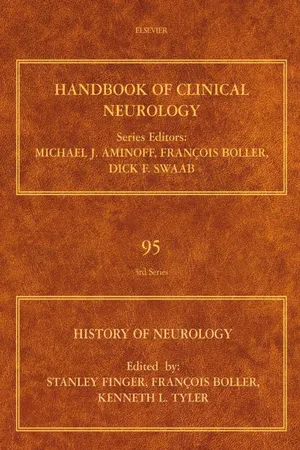
- 944 pages
- English
- PDF
- Available on iOS & Android
History of Neurology
About this book
Handbook of Clinical Neurology: Volume 95 is the first of over 90 volumes of the handbook to be entirely devoted to the history of neurology. The book is a collection of historical materials from different neurology professionals. The book is divided into 6 sections and composed of 55 chapters organized around different aspects of the history of neurology. The first section presents the beginnings of neurology: ancient trepanation, its birth in Mesopotamia, ancient Egypt; the emergence of neurology in the biblical text and the Talmud; neurology in the Greco-Roman world and the period following Galen; neurological conditions in the European Middle Ages; and the development of neurology in the 17th and 18th centuries. The second section narrates the birth of localization theory; the beginning of neurology and histological applications, neuroanatomy, neurophysiology, surgical neurology and other anatomo-clinical methods. The third section covers further development of the discipline, including methods of neurological illustration and hospitals in neurology and neurosurgery. This section also narrates the history of child neurology, neurodisability and neuroendocrinology. It also features the application of molecular biology on clinical neurology. The fourth section describes the dysfunctions of the nervous system and their history. The fifth and last section covers the regional landmarks of neurology and the different treatments and recovery. The text is informative and useful for neuroscience or neurology professional, researchers, clinical practitioners, mental health experts, psychiatrists, and academic students and scholars in neurology.* A comprehensive accounting of historical developments and modern day advancements in the field of neurology* State-of-the-art information on topics including brain damage and dysfunctions of the nervous system* New treatments and recovery methods from redundancy to vicariation and neural transplantation, amongst others
Frequently asked questions
- Essential is ideal for learners and professionals who enjoy exploring a wide range of subjects. Access the Essential Library with 800,000+ trusted titles and best-sellers across business, personal growth, and the humanities. Includes unlimited reading time and Standard Read Aloud voice.
- Complete: Perfect for advanced learners and researchers needing full, unrestricted access. Unlock 1.4M+ books across hundreds of subjects, including academic and specialized titles. The Complete Plan also includes advanced features like Premium Read Aloud and Research Assistant.
Please note we cannot support devices running on iOS 13 and Android 7 or earlier. Learn more about using the app.
Information
Table of contents
- Front Cover
- Handbook of Clinical Neurology
- Series Editors
- Copyright
- List of contributors
- Contents
- Beginnings
- Chapter 1: Ancient trepanation
- Chapter 2: Mesopotamia
- Chapter 3: Neurology in Ancient Egypt
- Chapter 4: Neurology in the Bible and the Talmud
- The Greco-Roman world
- Chapter 6: After Galen: late Antiquity and the Islamic world
- Chapter 7: Neurological conditions in the European Middle Ages
- Chapter 8: The development of neurology and the neurological sciences in the 17th century
- Chapter 9: Understanding the nervous system in the 18th century
- Origins of modern neurology
- Chapter 10: The birth of localization theory
- Chapter 11: On the use of animal experimentation in the history of neurology
- Chapter 12: The anatomical foundations of clinical neurology
- Chapter 13: The contributions of neurophysiology to clinical neurology: an exercise in contemporary history
- Chapter 14: Landmarks of surgical neurology and the interplay of disciplines
- Chapter 15: Jean-Martin Charcot and the anatomo-clinical method of neurology
- Chapter 16: History of the development of the neurological examination
- Chapter 17: Cognitive assessment in neurology
- Chapter 18: The origins of functional brain imaging in humans
- Further developments of the discipline
- Chapter 19: Visual images and neurological illustration
- Chapter 20: Neurological illustration: from photography to cinematography
- Chapter 21: Special hospitals in neurology and neurosurgery
- Chapter 22: A history of child neurology and neurodisability
- Chapter 23: History of neuroendocrinology: ``the spring of primitive existence´´
- Chapter 24: The coming of molecular biology and its impact on clinical neurology
- Dysfunctions of the nervous system
- Chapter 25: Headache: an historical outline
- Chapter 26: A history of seizures and epilepsies: from the falling disease to dysrhythmias of the brain
- Chapter 27: A history of cerebrovascular disease
- Chapter 28: A history of bacterial meningitis
- Chapter 29: Historical aspects of the major neurological vitamin deficiency disorders: overview and fat-soluble vitamin A...
- Chapter 30: Historical aspects of the major neurological vitamin deficiency disorders: the water-soluble B vitamins...
- Chapter 31: Muscular dystrophy
- Chapter 32: Sensory and perceptual disorders
- Chapter 33: The history of movement disorders
- Chapter 34: The history of sleep medicine
- Chapter 35: The frontal lobes
- Chapter 36: History of aphasia: from brain to language
- Chapter 37: Alexia and agraphia
- Regional landmarks
- Chapter 38: American neurology
- Chapter 39: An historical overview of British neurology
- Chapter 40: History of neurology in France
- Chapter 41: The history of neurology in Scandinavia
- Chapter 42: Neurology and the neurological sciences in the German-speaking countries
- Chapter 43: The development of neurology in the Low Countries
- Chapter 44: History of neurology in Italy
- Chapter 45: A history of Russian and Soviet neuro(patho)logy
- Chapter 46: Neurology and traditional Chinese medicine
- Chapter 47: History of clinical neurology in Japan
- Chapter 48: History of neurology in Australia and New Zealand
- Chapter 49: Clinical neurology in Latin America
- Chapter 50: History of tropical neurology
- Chapter 51: Recovery of function: redundancy and vicariation theories
- Chapter 52: The emergence of the age variable in 19th-century neurology: considerations of recovery patterns in acquired chil
- Chapter 53: Rehabilitation therapies
- Chapter 54: The discovery of neurotransmitters, and applications to neurology
- Chapter 55: Neural transplantation
- titlelink1